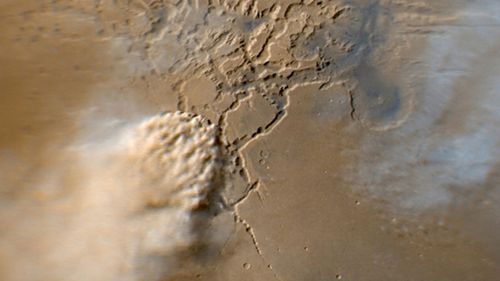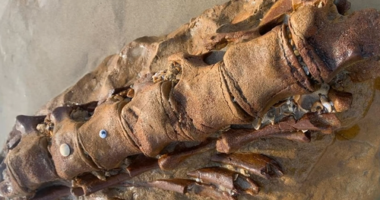Share this @internewscast.com
Twenty years’ worth of imagery captured by two orbiters circling Mars has revealed raging winds on the red planet.
Mars is a barren planet where the wind remains unseen, except for when it stirs up the planet’s famous red dust, resulting in swirling dust devils.

An advantageous aerial view
The orbiters aren’t equipped with tools specifically for measuring wind speeds on Mars. However, Bickel and his team found valuable data hidden within what would typically be considered a distraction.
These orbiters capture images by merging observations from different channels targeted at specific colors or directions on Mars. For instance, Mars Express can craft one image by using nine different channels, with time lags ranging from seven to 19 seconds between channels.
Thus, any movement on Mars, like a dust devil, causes distinct “color offsets” in the completed mosaic image, providing a method to assess the speed and movement of these dust devils.
Faster dust devils tend to travel in very straight lines, while slower dust devils wobble from left to right, Bickel said.
Past assessments revealed that dust devils typically moved at sustained speeds under 50km/h, sometimes reaching up to 100km/h. However, recent data indicates a significantly higher maximum speed for dust devils and the winds around them.
“These robust, straight-line winds are likely to carry substantial amounts of dust into Mars’s atmosphere—far more than previously estimated,” Bickel commented. “Our observations identify where and when the winds on Mars are potent enough to lift dust from its surface.”
But Mars’ atmosphere is more than 100 times thinner than Earth’s, meaning that even strong winds would feel more like a breeze to us. Without a substantial atmosphere, wind lacks force — but on Mars, it’s just enough to pick up dust.
“A dust devil would certainly not be able to kick you off your feet,” Bickel said.
Picking the perfect landing site
Dust remains a primary concern for missions heading to Mars. Suspended Martian dust can lead to planet-encircling dust storms, a phenomenon which ended the Opportunity mission in 2019. And a buildup of dust on the stationary lander InSight’s solar panels put an end to that mission in 2022.
Sometimes, dust devils can be helpful. By chance, the vortices helped clear dust from solar panels on the Spirit rover in 2009.
Bickel said that new images from orbital data will continue to be added to the catalogue so it can serve as a resource for future mission planning.
“Our measurements could help scientists build up an understanding of wind conditions at a landing site before touchdown, which could help them estimate how much dust might settle on a rover’s solar panels – and therefore how often they should self-clean,” Bickel said.
Data from the new study is already being used to help determine the optimal landing site for ESA’s ExoMars Rosalind Franklin rover, expected to touch down on Mars in 2030.













